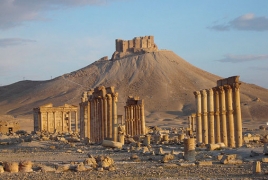Getty Research Institute acquires early photos of Palmyra October 2, 2015 - 13:46 AMT PanARMENIAN.Net - The Getty Research Institute announced the acquisition of a suite of extremely well-preserved photos taken in 1864 by Louis Vignes representing views and panoramas of Beirut, Lebanon and the Roman ruins in Palmyra, Syria,. Two temples featured in the photographs of Palmyra, a UNESCO World Heritage Site, were reportedly destroyed by ISIS this year, Art Daily reports. “Beirut, Lebanon and Palymyra, Syria have been irreparably altered both by the 1975 Lebanese war and the current Syrian war. In the face of the unspeakable human tragedy and cultural destruction of these conflicts, there is little scholars can do but strive to record, preserve, and interpret the historical record of these tremendously important historic sites,” said Thomas W. Gaehtgens, director of the Getty Research Institute. “Because of recent events, these rare photographs are now even more valuable as research documents for scholars of the Middle East.” Louis Vignes was a French naval officer who was trained in photography by the renowned photographer Charles Nègre. Views and Panoramas of Beirut and the Ruins of Palmyra comprise a group of 47 prints shot by Vignes and printed by Nègre; they represent the earliest photographs of the Roman ruins in Palmyra and some of the earliest views of Beirut. The photographs were taken during an expedition financed by the French art collector, archaeologist and scientist, the duc de Luynes. Inspired by studying the biblical and historical past of Christianity, Luynes headed one of the earliest scientific missions of the Dead Sea to investigate its geomorphic and climatic features, as well as its natural resources. During this trip, he negotiated the acquisition of a number of ancient archeological artifacts for the Louvre collections and also commissioned Vignes to photograph Beirut and Palmyra, following the exploration of the Dead Sea. Although the scientific account of the Dead Sea was not published until 1875 (as three volumes and an “atlas” of photogravures and lithographs), Nègre printed photographs of all of Vignes negatives—including the 47 albumen prints from Beirut and Syria now at the GRI—for the duc's personal collection, presumably before his death in 1867. Beirut Vignes’ photographs of Beirut, comprising three panoramas of the port and city and six single images, indicate the importance this site held both strategically and in the Western imagination. During the nineteenth century Beirut had emerged as the most significant port of the region and a major center of silk production. Vignes’ photographs of Beirut and its surrounding area picture a serene city ringed by majestic pine trees. Syria Dating back as a settlement to the Neolithic period, Palmyra reached its apex in the mid-third century as an eastern city of the Roman Empire. An oasis in the Syrian desert, northeast of Damascus, Palmyra contains the monumental ruins of a great city that was one of the most important centers of the ancient world. Vignes’ 150-year-old photographs of Palmyra capture multiple views of the site including its monumental colonnade, the great tombs bordering the city, as well as the Temple of Bel and the Temple Baal Shamin, both reportedly destroyed in recent months. “The ongoing Syrian Civil War now threatens to obliterate Palmyra utterly. These photographs represent rare primary documents of a region and World Heritage Site in crisis, preserving the memory of its ancient monuments and natural beauty for posterity,” said Frances Terpak, curator of photography at the Getty Research Institute. “Additionally, Vignes’ striking photographs are exceedingly important as documents both for the history of archaeology, which blossomed in the mid-nineteenth century, and the history of photography—having been printed by Charles Nègre.” Views and Panoramas of Beirut and the Ruins of Palmyra is complemented in the GRI archive by the duc of Luynes' personal album of 58 photographs also printed from Vignes’ negatives, depicting the regions of Phoenicia, Judea, Moab on the eastern shore of the Dead Sea, and the ancient city of Petra, in addition to the duc's posthumous publication on the same subject. The GRI also holds many early publications that reference Palmyra, beginning with Abednego Seller's 1696 book, The Antiquities of Palmyra. And a unique and extraordinary collection of printed proofs, drawings, and a manuscript made in preparation for the magnificent publication by Louis François Cassas, Voyage pittoresque de la Syrie, de la Phoenicie, de la Palaestine, et de la Basse Aegypte, published in three volumes in Paris in 1799-1800, are also in the GRI’s Special Collections. Views and Panoramas of Beirut and the Ruins of Palmyra is currently available to scholars for research. The creative crew of the Public TV had chosen 13-year-old Malena as a participant of this year's contest. She called on others to also suspend their accounts over the companies’ failure to tackle hate speech. Penderecki was known for his film scores, including for William Friedkin’s “The Exorcist”, Stanley Kubrick’s “The Shining”. The festival made the news public on March 19, saying that “several options are considered in order to preserve its running” Partner news |